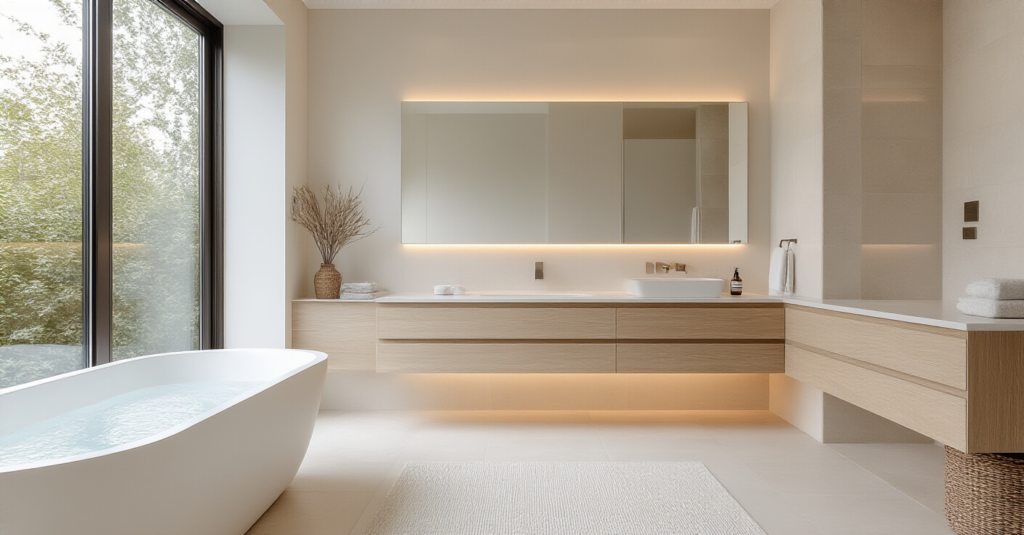You know, I’ve noticed something peculiar about how people approach a “modern” bathroom. They see these images in magazines—all stark white, sharp angles, and cold surfaces—and they chase that look. They think modern means a sterile, almost surgical precision.
But they’re missing the entire point.
A modern bathroom is not a showroom. It is, or it should be, a sanctuary. It’s the first space you enter to prepare for the day and the last space you visit to wash it away. It’s a place for quiet ritual. What truly matters is not how a space looks, but how it makes you feel. And it should feel like a deep, calming breath.
The secret is not about having less, but about making what you have more meaningful. This is where we can learn from centuries of Japanese thought on creating harmony. So, let’s talk about how to build a space that offers true quiet and light.
Laying the Modern Foundation: Design Principles & Materials
Everything begins with the foundation. This is not about the plumbing or the studs in the wall, but the philosophical foundation. It’s about creating a canvas of quiet that allows you to breathe, think, and simply be. These principles are the unspoken language of the room.
1. Master a Minimalist Color Palette for Serene Ambience
People hear “minimalist palette” and think of an empty, sterile white box. That is a deep misunderstanding. The purpose of a limited palette—soft whites, quiet grays, warm earth tones—is not emptiness. It’s about creating ma, or negative space. When the walls and floors don’t scream for attention, your mind has room to settle. It creates a visual quiet that allows the dance of light and shadow to become the room’s art.
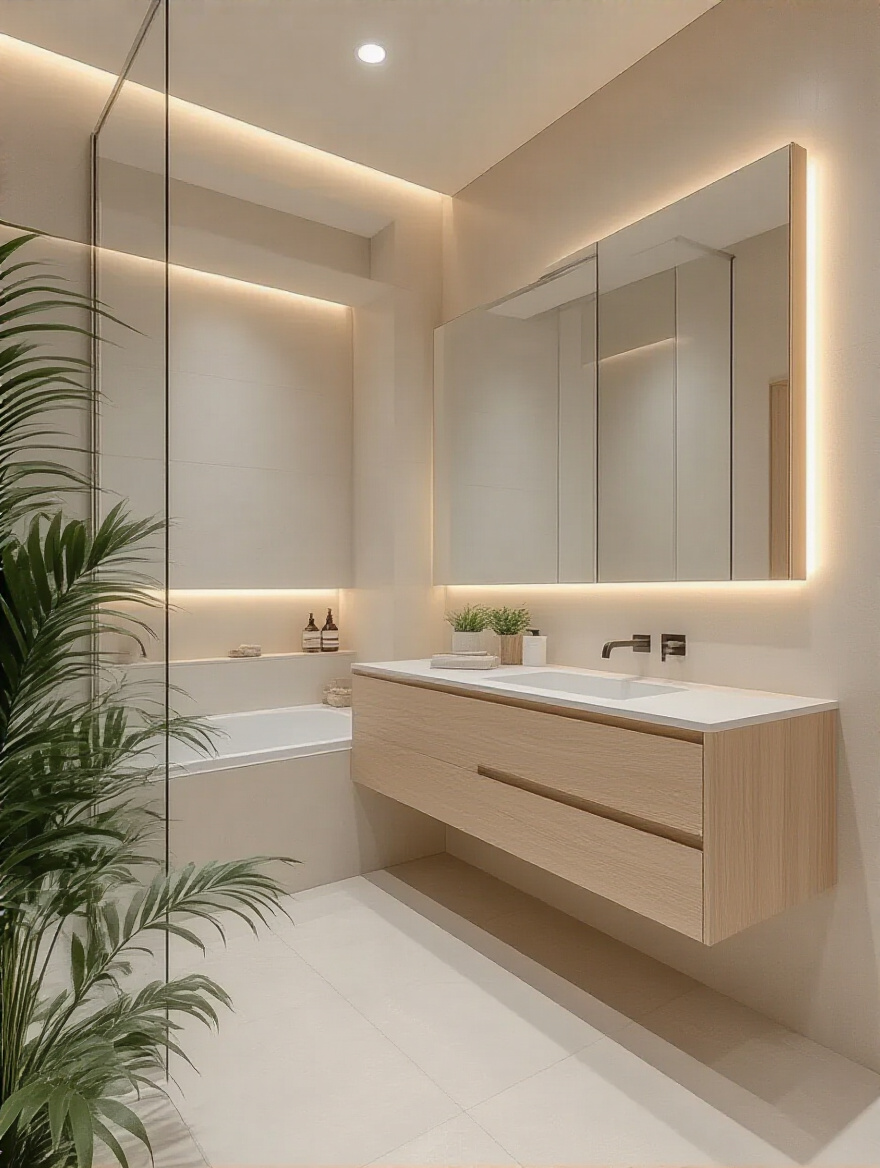
The shortcut is to understand that “neutral” is not one color. Find a white with a warm, creamy undertone, or a gray that feels like a soft river stone. Then, layer textures within that limited palette. A matte wall against a polished stone counter. A honed tile floor beside a soft, slubby linen towel. This is the difference between a sterile room and a serene one. The BS is that you need “pops of color” to make it interesting. No. You need depth of texture. I once had a client who was afraid her all-beige bathroom would be boring. We used six different textures of beige, from rough-hewn wood to smooth plaster, and it became the most calming and complex room in her house.
Now, on this quiet canvas, we must introduce the soul of the space.
2. Choose Natural Materials to Introduce Organic Warmth
A room of only plaster and porcelain has no life. The modern soul finds its warmth through shizen, the principle of bringing nature into the home. Wood, stone, bamboo, cotton—these materials connect us to the world outside. They carry an inherent imperfection, a story. This is the heart of wabi-sabi: finding beauty in the things that are not perfectly uniform. A plank of hinoki wood releasing its faint, clean scent in the steam of a shower is more luxurious than any gold-plated tap.
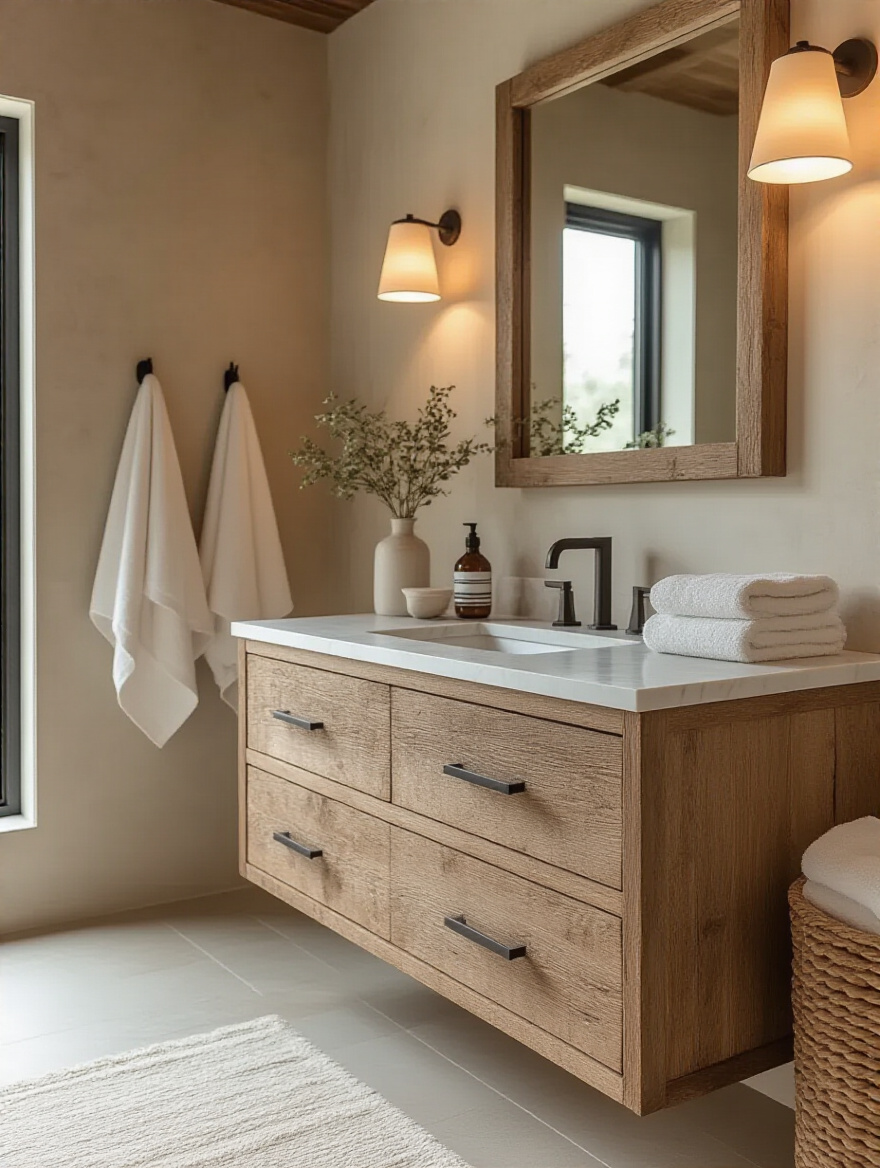
The common mistake is treating these materials like any other. You cannot simply install an untreated wood wall and walk away. Choose woods that welcome moisture, like teak or cedar. Ensure stone is properly sealed to honor its longevity. Feel the materials. A client once felt their high-tech bathroom was cold and alienating. We simply replaced the slick tile floor of his shower with smooth river stones. The feeling of those stones under his feet each morning completely changed his relationship with the space. It grounded him.
This connection to nature’s honesty informs how we shape the space itself.
3. Maximize Open Space with Intelligent Layout Strategies
Western design often focuses on what you can fill a space with. But the real art is in what you leave out. Every object takes up not just physical space, but visual and mental space. An intelligent layout isn’t about cramming in a bigger tub; it’s about creating uninterrupted floor and sight lines so the room feels expansive and your mind feels uncluttered.
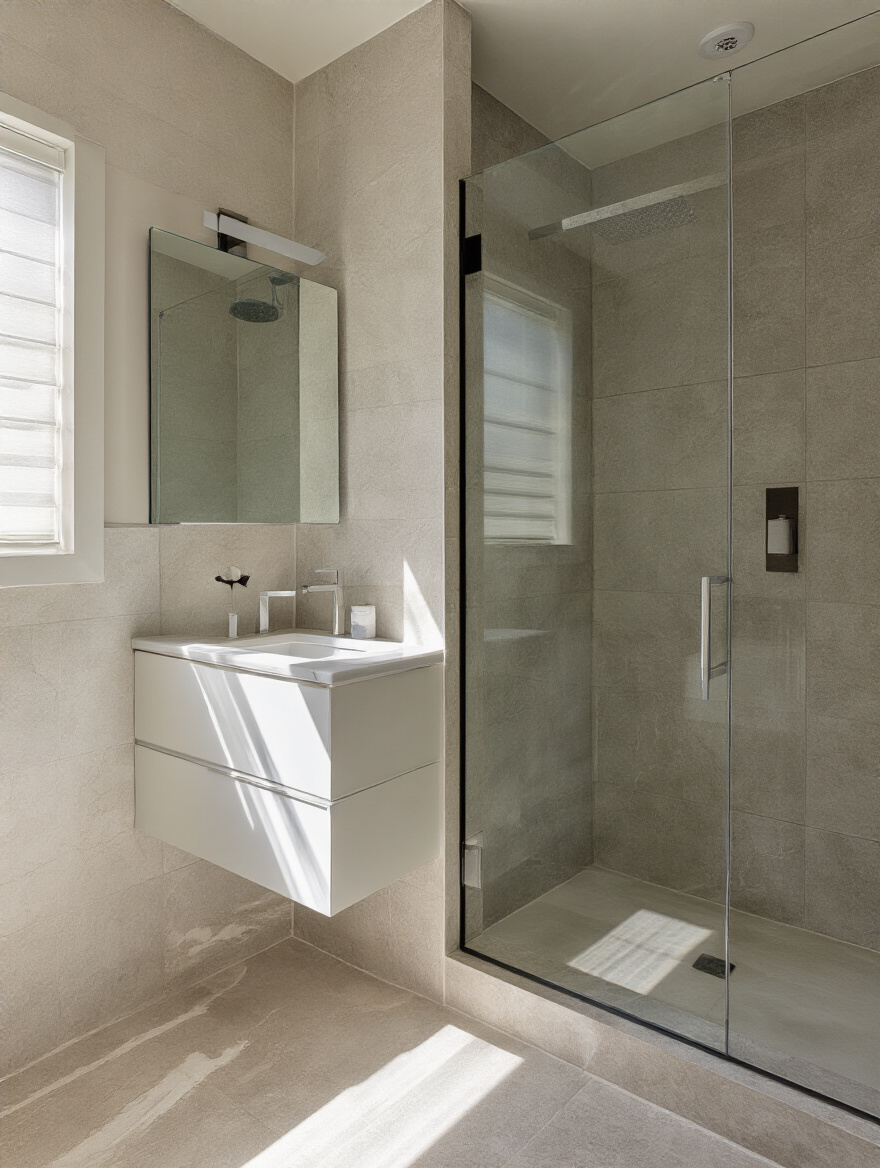
This is where you think architecturally. A pocket door that slides into the wall doesn’t just save nine square feet; it removes the visual interruption of a door’s swing. A wall-mounted vanity creates a clear, unbroken floor plane that the eye can travel across, making a small room feel vast. People always ask me for my biggest small-bathroom trick. This is it. Stop thinking about fixtures. Start thinking about the space between them. That empty space is what you’re actually designing. It’s the most valuable material you have.
This idea of uninterrupted flow extends to the surfaces we use.
4. Integrate Large-Format Tiles for a Seamless, Expansive Look
Why do we prefer large tiles in a modern space? Because grout lines are visual noise. They create a grid, a pattern that chops a surface into tiny pieces. Each line is a small interruption for the eye and, by extension, the mind. A large-format tile, especially one where the grout is colored to match, creates a unified, serene surface. It’s the principle of kanso—simplicity.
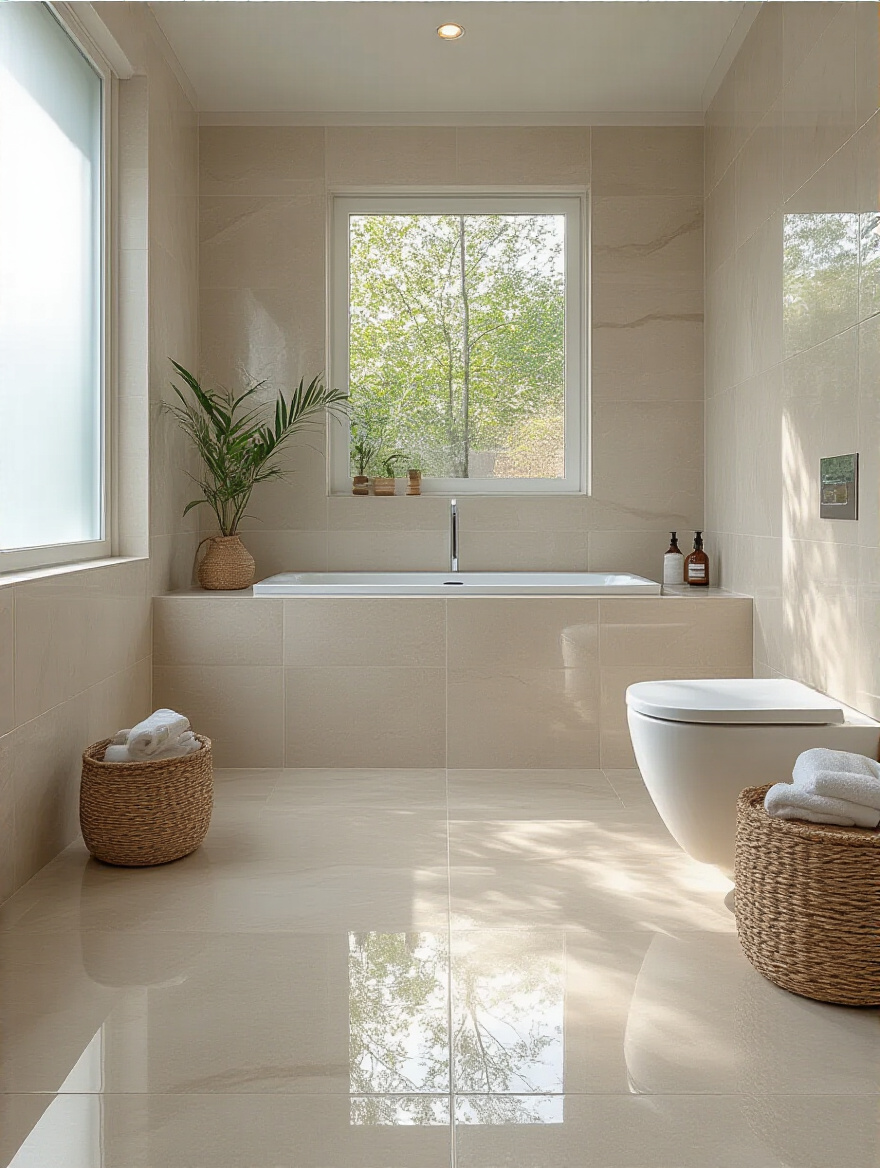
I wish someone had told me earlier that the single most effective way to make a small bathroom feel grand is to use the largest tiles possible on the floor and walls. You create a continuous canvas. People get this wrong when they pick a beautiful large tile and then use a starkly contrasting grout color. You’ve just defeated the entire purpose. The goal is to make the seams disappear, to create a sense of a space carved from a single, solid element. It is calm, powerful, and profoundly simple.
This simplicity is the guiding force behind our final foundational thought.
5. Prioritize Clean Lines and Uncluttered Surfaces
Clean lines are not about rigidity. They are about flow. Think of a raked sand garden. The lines are not there to be harsh; they are there to guide the eye and calm the mind. In a bathroom, this means choosing fixtures that don’t shout with ornate details. It means having a place for everything, so that the surfaces can remain clear. A cluttered countertop is a cluttered mind. It is a visual to-do list of half-used bottles and stray items.
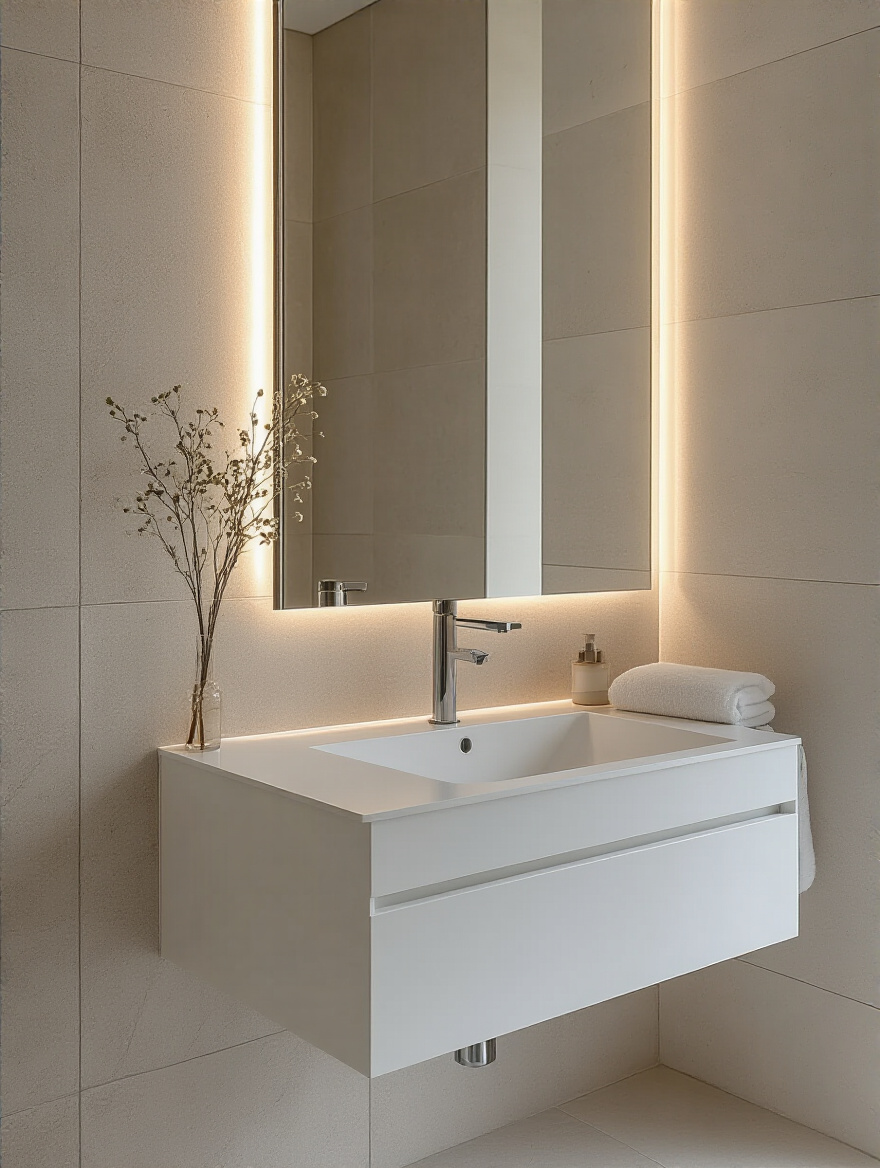
The secret here is to be ruthless about planning your storage before you do anything else. Where will the electric toothbrush live? Where will the extra soap go? If you don’t design a home for these things, they will colonize your countertops and shatter any sense of peace you hoped to create. The most successful spaces I’ve designed are the ones where the daily necessities are hidden but accessible—in recessed niches, in well-organized drawers. The tranquility of an empty surface is a luxury you must actively design for.
Once this quiet foundation is laid, we can choose the elements that will inhabit it.
Core Modern Elements: Fixtures & Furnishings Selection
The objects we place within our quiet space must honor its principles. Each fixture should be chosen not just for its function, but for its form and its contribution to the overall feeling of harmony. This is where simplicity meets daily use.
6. Install Floating Vanities for Enhanced Space Perception
A floating vanity is a perfect expression of ma. By lifting the cabinet off the floor, you create breathing room. The space is no longer heavy, anchored, and dense. It feels light. The floor flows uninterrupted beneath it, and this simple trick of the eye makes the entire room feel larger, more open, more free. It’s an architectural choice that has a profound psychological effect.
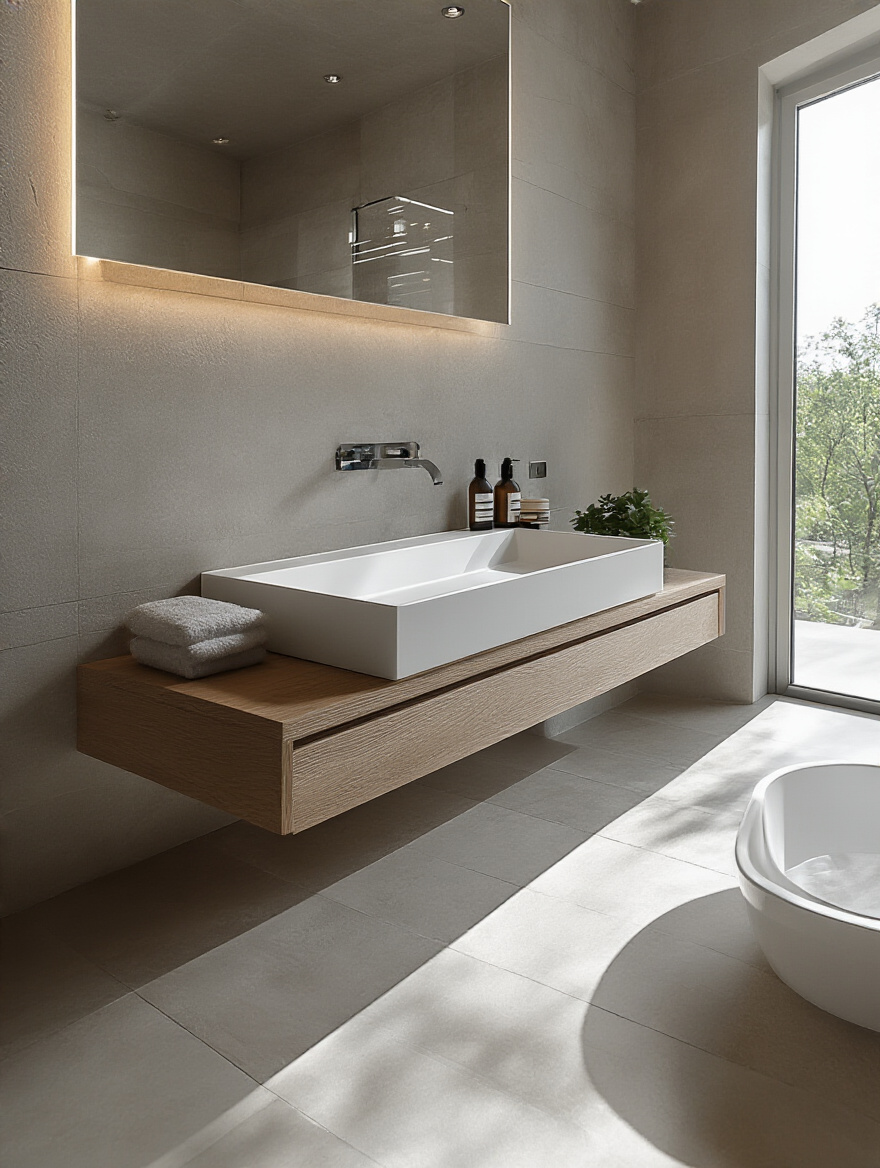
Don’t just pick one from a catalog. Consider its proportion. In a small space, a narrower, longer floating vanity can accentuate the length of a room. The most common mistake is failing to have the wall properly reinforced. This isn’t just a cabinet; it’s a small piece of architecture, and it needs a strong connection to the home’s bones. I often suggest integrating a soft, dimmable LED strip underneath. It enhances the floating effect and provides a gentle, guide-light in the dark—functional, beautiful, and thoughtful.
From the vanity, our sense of flow continues into the bathing area itself.
7. Embrace Curbless Walk-In Showers for Sleek Functionality
The traditional shower has a curb, a lip, a frame. These are all barriers. They break the flow of the floor and visually chop the room into separate zones. A curbless shower, where the floor flows seamlessly from the dry area into the wet, dissolves that boundary. It creates one unified space, which feels more expansive and generous. It’s also a deeply practical choice, removing a trip hazard and offering a sense of effortless accessibility.
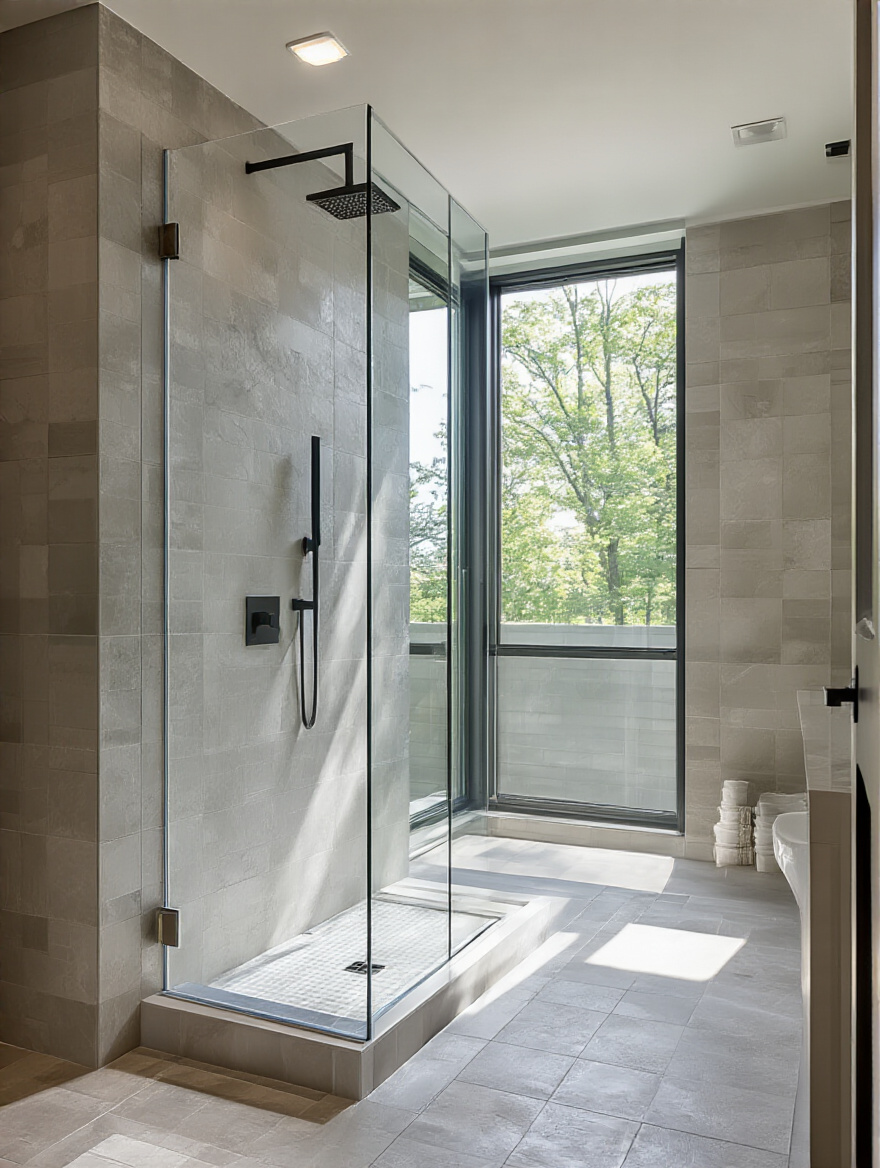
Getting this right is entirely about what you don’t see: the slope and the waterproofing. This is not a DIY weekend project. A poorly sloped floor will lead to pooling water, and failed waterproofing is a catastrophe waiting to happen. Find an expert who understands how to create that subtle, almost imperceptible slope to a linear drain. When done correctly, the result is sublime—a space where you can walk into a cascade of water without ever stepping over a barrier. It’s a feeling of true freedom.
This same principle of unburdening the floor applies to another key fixture.
8. Select Wall-Mounted Toilets to Simplify Cleaning, Maximize Floor
Like the floating vanity, a wall-mounted toilet is an exercise in visual lightness. By hiding the tank in the wall and lifting the bowl from the floor, you remove a bulky, awkward form from the room. The floor beneath is clear, simple, and easy to clean. You are removing visual clutter and physical obstruction. It simplifies the form of the object to its most essential nature.
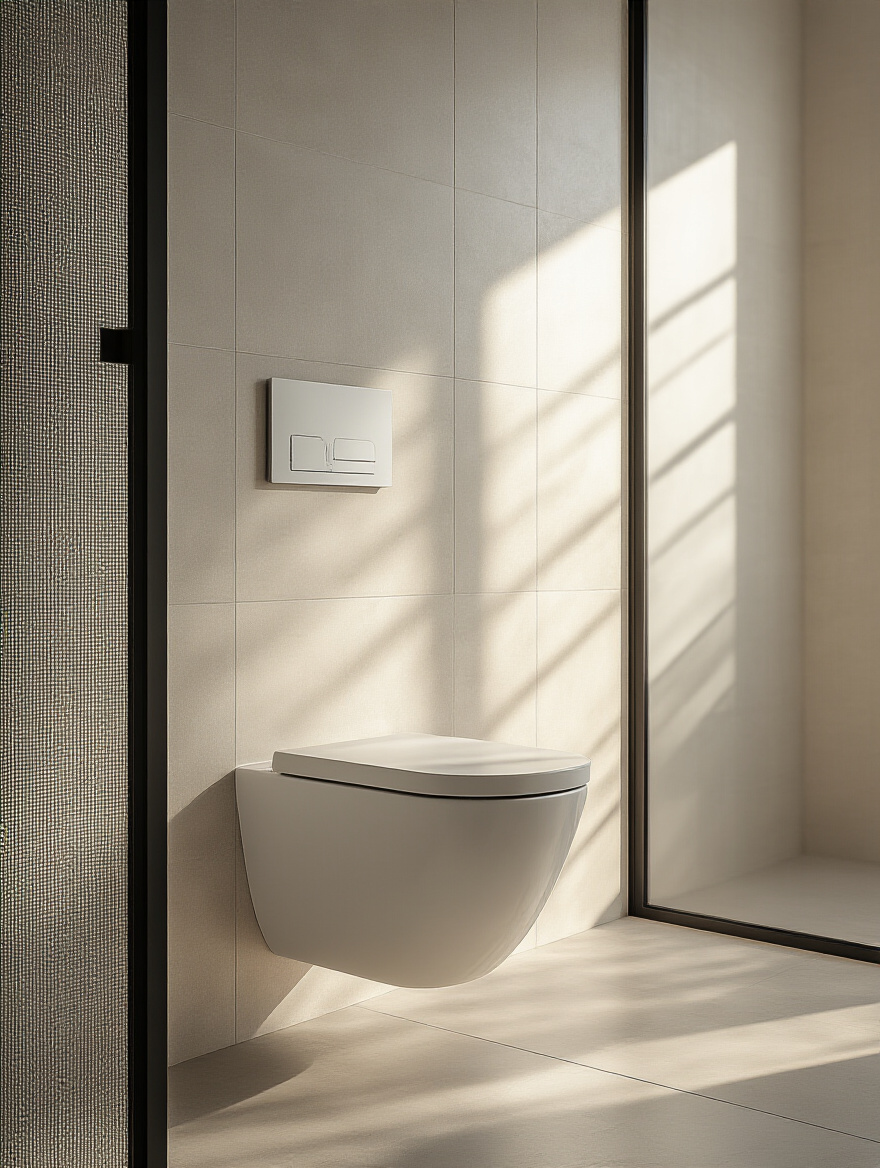
People worry about the mechanics hidden in the wall. “What if something breaks?” This is a valid question, and the answer is to invest in a high-quality carrier system from a reputable brand like Geberit or TOTO. These systems are engineered for incredible strength and reliability, and all the working parts are accessible through the flush plate. The shortcut you can’t afford to take is hiring a plumber who hasn’t installed one before. It requires precision. The reward is a bathroom that feels cleaner, larger, and more composed.
This sense of visual lightness continues with how we contain the shower spray.
9. Opt for Frameless Glass Shower Enclosures to Elevate Transparency
A framed shower door is a visual cage. A frameless enclosure, especially one using low-iron, ultra-clear glass, is almost like a ghost. It is there, but it is barely there. It allows light to pass through unimpeded. It allows the tile or stone of your shower to be seen as a continuous part of the room, not as a separate decorated box. This simple choice does more to make a bathroom feel open and luxurious than almost any other.
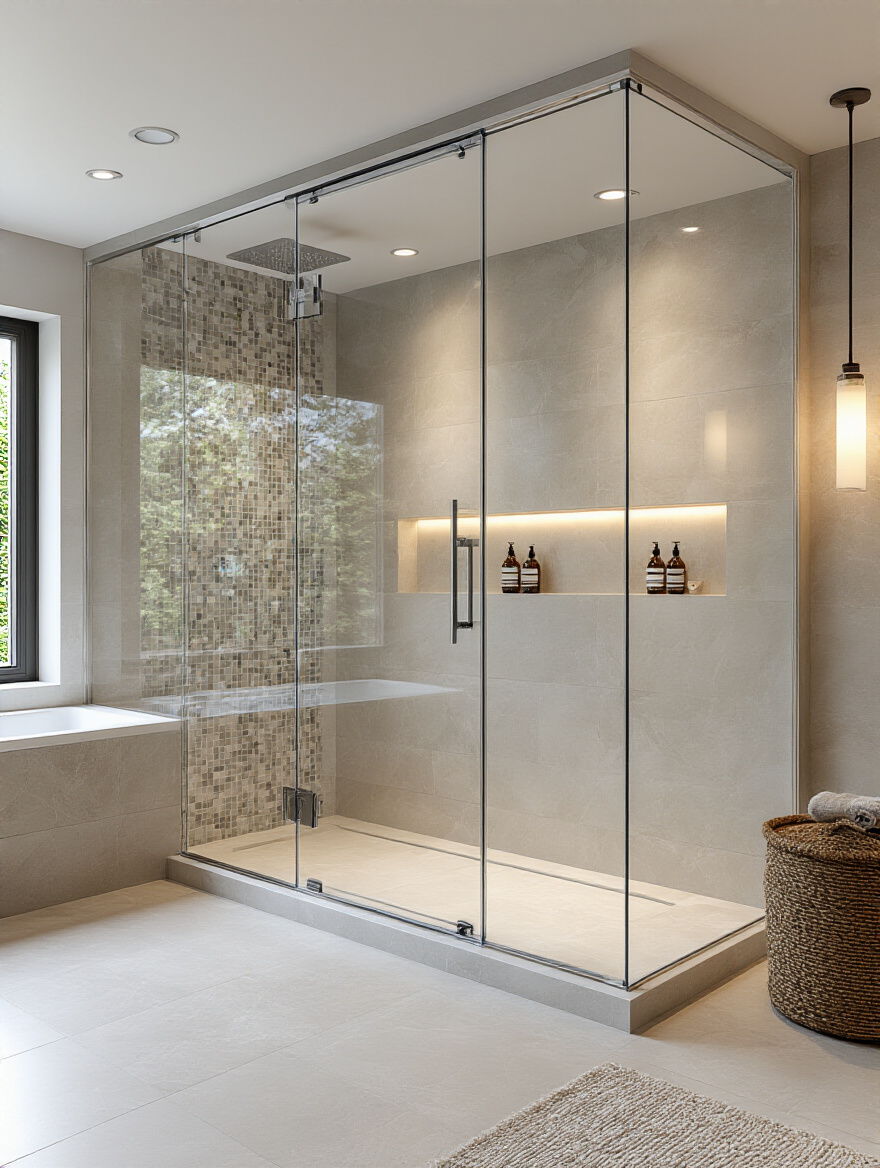
The secret I wish everyone knew is to spend a little extra on the low-iron glass. Standard glass has a subtle green tint that becomes very obvious on the thick edge. It places a “filter” between you and the shower. Ultra-clear glass is practically invisible. And please, use a professional installer. The precision required to align these heavy panels of glass and seal them properly is a true craft. The goal is an enclosure so minimal it almost disappears, leaving only light and space.
Now, against this backdrop of transparency and light, we need a point of focus.
10. Choose Matte Black or Brushed Brass Fixtures for Contemporary Contrast
In a space of quiet simplicity, a single element of contrast has immense power. Think of a single, powerful brushstroke on a silk scroll. This is the role of a matte black or brushed brass fixture. It is a deliberate choice, a punctuation mark. A matte black faucet against a light, textured wall creates a focal point that is both grounding and modern. A brushed brass fixture offers a softer warmth, a glow that feels more like firelight than electric light.
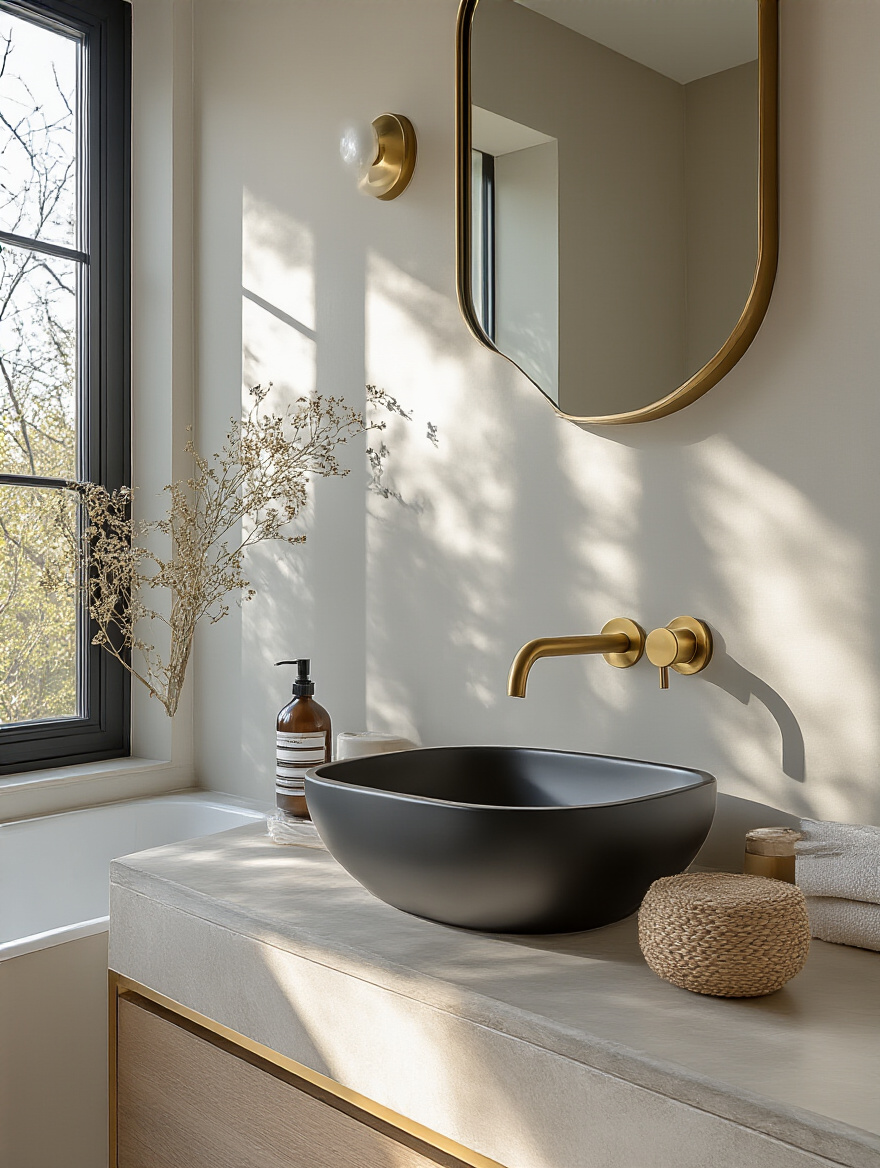
The BS everyone says is to be afraid of “trends.” Don’t choose these finishes because they are trendy; choose them for what they do. A dark finish grounds a space. A warm metal finish brings life. The key is consistency. Choose one, and carry that metal through the faucet, the shower controls, and even the cabinet hardware. This repetition creates a quiet rhythm. I once worked on a very serene, all-white bathroom that felt a little lost. The moment we installed the matte black fixtures, the entire room clicked into focus. It finally had a point of view.
With these core pieces in place, we turn to the most ethereal element of all: light.
Illumination & Smart Storage Solutions
Light and shadow are not accessories; they are primary materials in design. How a space is lit determines its mood, its function, and its soul. Equally important is how we create a sense of order through thoughtful, almost invisible, storage.
11. Implement Layered Lighting for Functional and Mood Creation
One single, harsh light in the center of the ceiling is a crime against tranquility. It flattens everything and casts unflattering shadows. A bathroom needs layers of light, just as a day has different qualities of light. You need bright, clear task light at the mirror for grooming. You need soft, general ambient light to fill the room with a gentle glow. And you need subtle accent light to highlight a beautiful texture or create a mood for a relaxing bath.
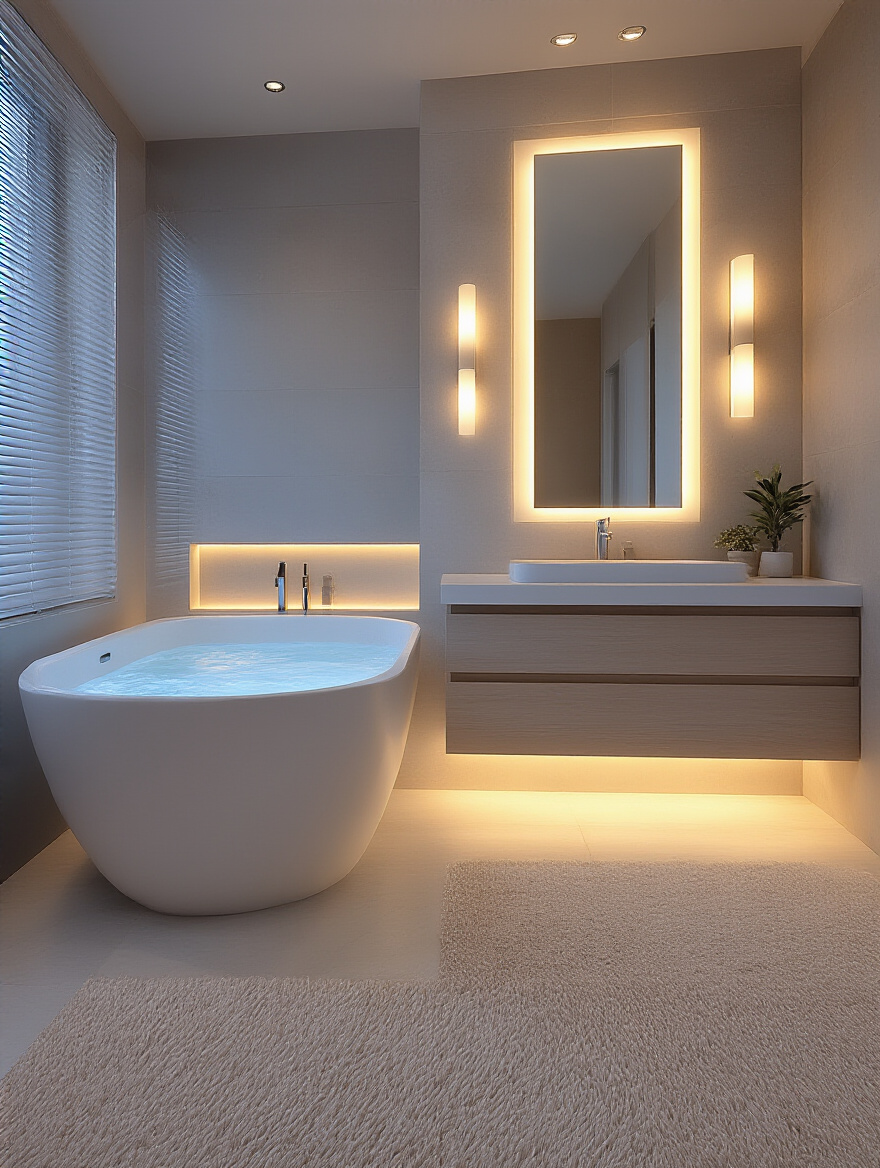
The single most important shortcut here is to put everything on a dimmer. Everything. This is non-negotiable. Dimming the lights is the simplest way to transform the room’s energy from functional and bright to restorative and calm. I learned this the hard way on an early project where we installed beautiful, expensive fixtures but no dimmers. The client loved the look but hated being in the room because it only had one setting: “interrogation.” Dimmer switches give you control over the feeling of your space.
We can take this layering even further with more focused sources.
12. Integrate LED Strips for Accentuated Architectural Features
LED strips are like a paintbrush made of light. They are a tool for creating soft, indirect glows from hidden places. Tucked under a floating vanity, they make it seem to hover. Placed inside a shower niche, they turn a simple storage spot into a softly lit altar for your daily rituals. Run along a ceiling cove, they wash the room in a gentle, even light. They are a way to highlight architecture and create mood without adding more visible “stuff” to the room.
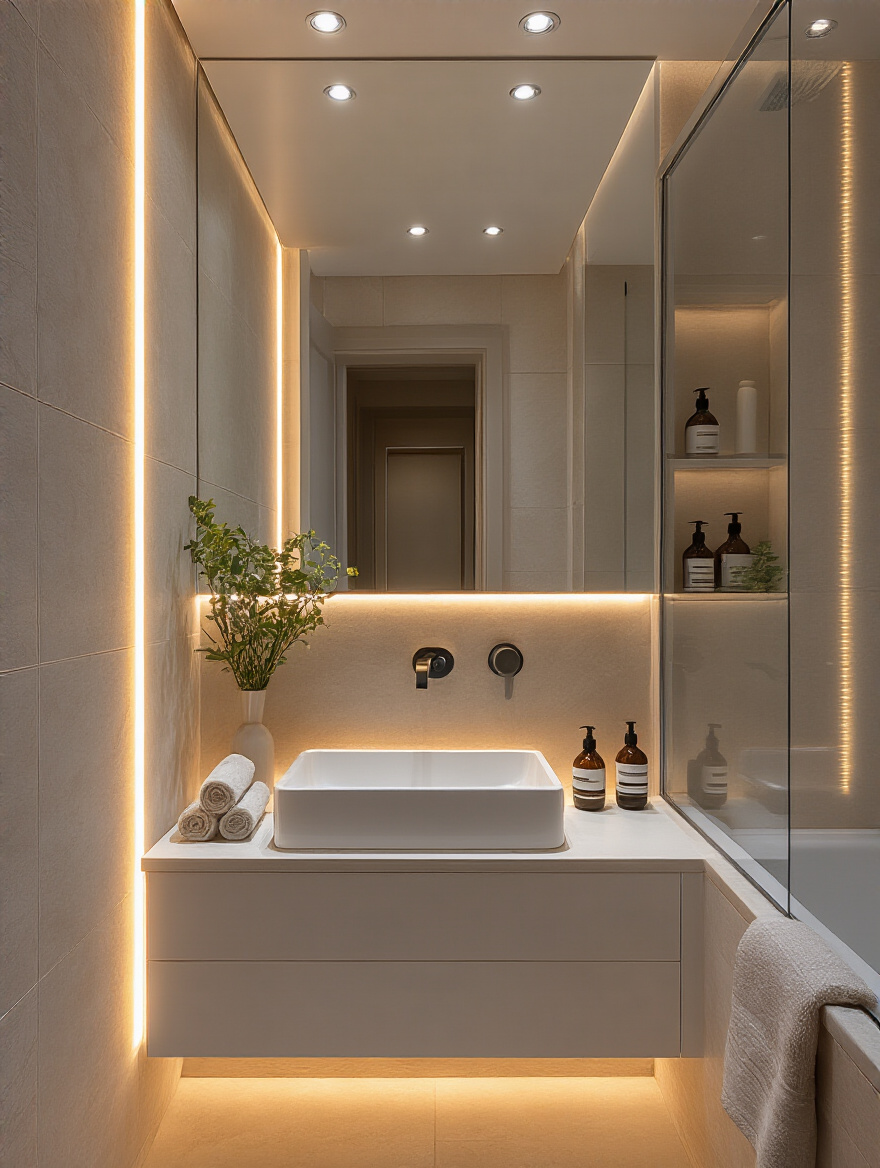
The mistake people make is buying the cheapest strips online and just sticking them on. For a bathroom, you need waterproof (IP65-rated or higher) strips housed in a metal channel with a diffuser. The channel helps dissipate heat, ensuring longevity, and the diffuser turns the individual dots of light into a smooth, continuous line. It’s the difference between a cheap-looking gimmick and a truly integrated, sophisticated architectural element. This is how you achieve that “spa glow.”
This same technology is now transforming a key functional element.
13. Select Backlit Mirrors for Superior Task Lighting, Modern Glow
The traditional way to light a face at a mirror is with sconces on either side. This is still an excellent method. But a backlit mirror offers something different. It provides perfectly even, shadowless light for the face, while also casting a soft halo of light onto the wall behind it. It’s a two-in-one fixture, providing both task and ambient light in one clean, simple form. It floats on the wall, a glowing plane that feels both futuristic and calming.

What people often get wrong is the color of the light. Look for mirrors that let you tune the color temperature, from a cool, bright white for applying makeup to a warm, soft glow for the evening. An even better shortcut is to find one with an integrated defogger. There is a quiet luxury in stepping out of a hot shower to a perfectly clear mirror. It’s a small, thoughtful detail that elevates the daily experience immeasurably.
But even the best light cannot fix the problem of clutter.
14. Incorporate Recessed Niches for Minimalist Storage Solutions
A shower caddy hanging from the showerhead is a symbol of design failure. It’s a visual and physical mess. A recessed niche, built into the wall, is the opposite. It is an expression of foresight and intention. It provides a simple, elegant home for shampoos and soaps, keeping them off the floor and out of sight lines. It transforms clutter into a clean, architectural element.
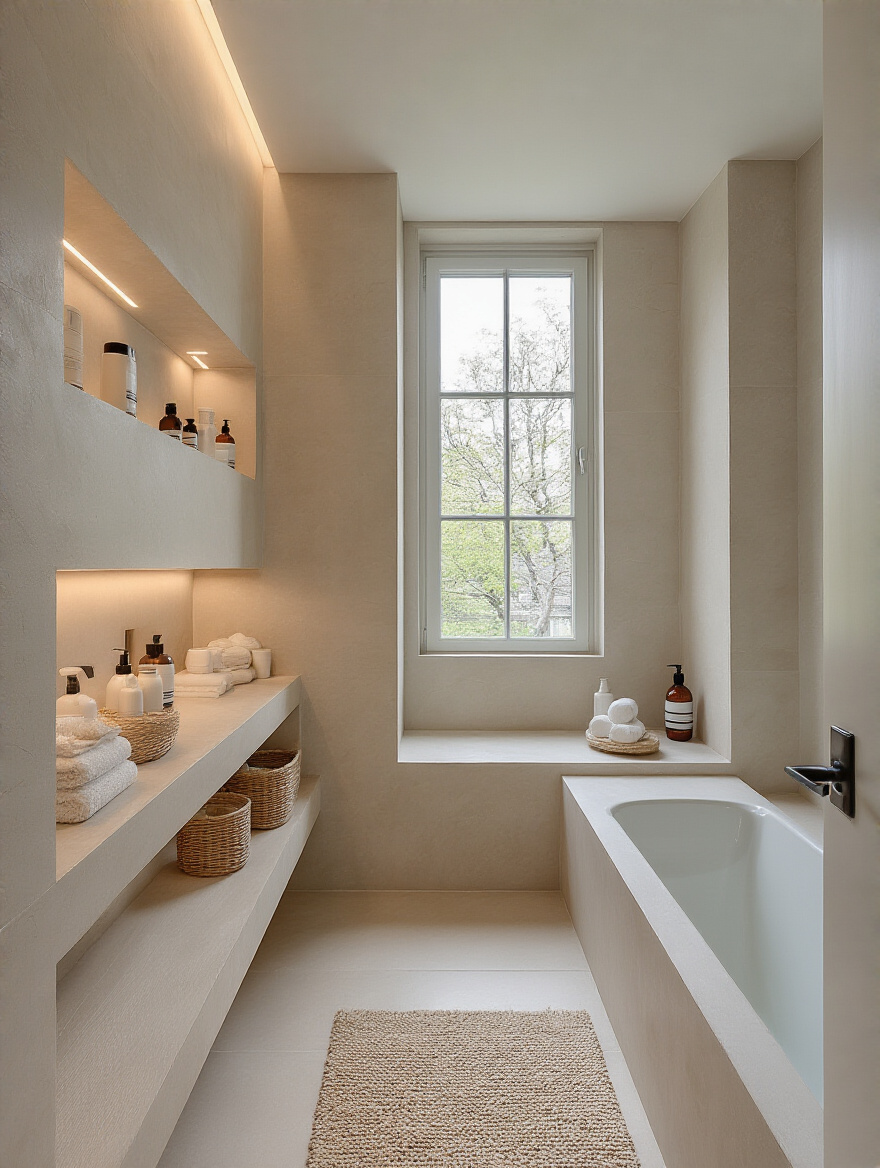
My advice is to always make them larger than you think you need. A small niche quickly becomes overcrowded. And think about the material inside. You can use the same tile as the rest of the shower for a seamless look, or you can use a contrasting tile to make it a subtle feature. But the most important part is waterproofing. Just like a curbless shower, a niche is an opening in the wall and must be perfectly sealed. A pre-fabricated, waterproof niche box is a shortcut that I highly recommend for peace of mind.
Now we move from the essentials to the elements that create true, personal luxury.
Advanced Features & Refined Finishing Touches
With the space defined and the core elements chosen, we can now add the layers that speak to ultimate comfort and personal expression. These are the details that transform a well-designed bathroom into your personal sanctuary.
15. Upgrade to Smart Toilets for Advanced Hygiene and Comfort
For many, this feels like an unnecessary extravagance. But I would ask you to think of it differently. In Japan, the ritual of bathing and personal cleanliness is central to well-being. A smart toilet, with its bidet functions, heated seat, and warm air dryer, is not a gadget. It is a tool for a higher level of personal care. It transforms a purely functional act into a moment of comfort and care.
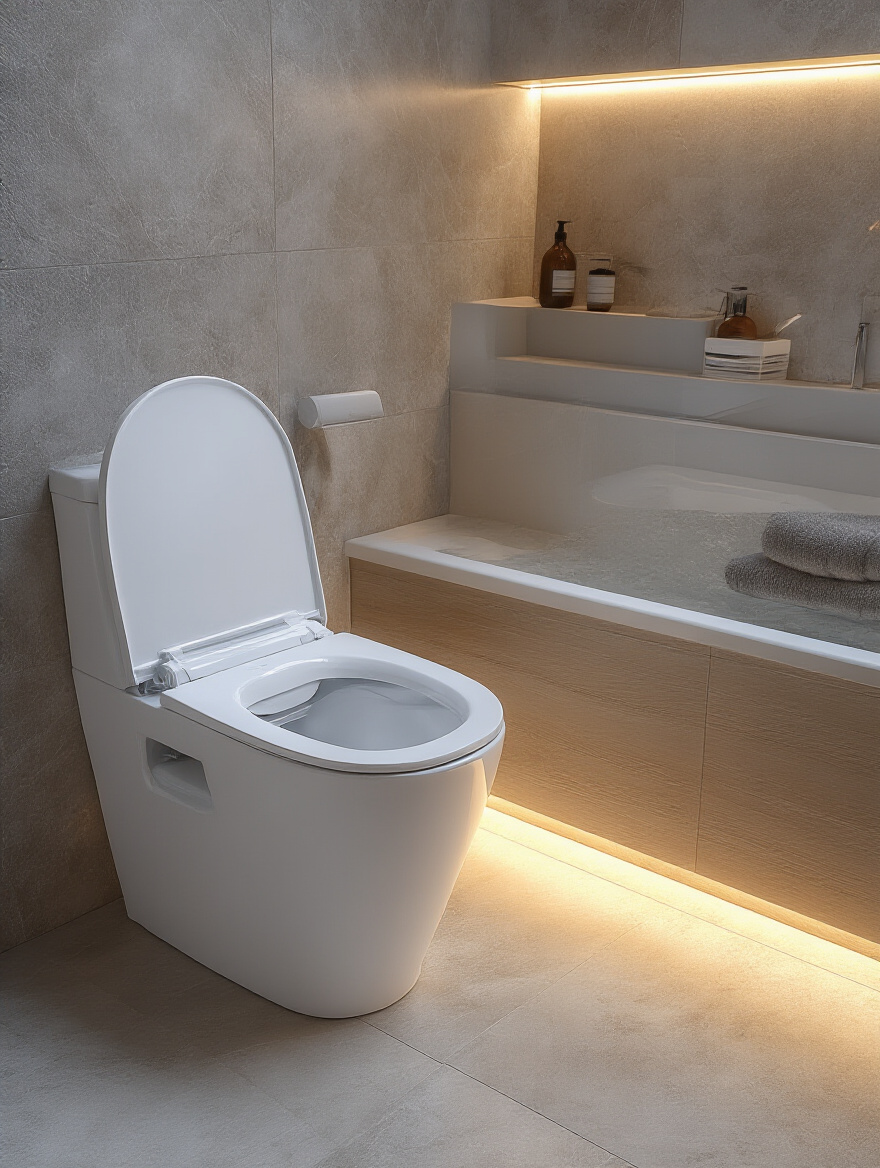
The “hard part” is simply the plumbing and electrical hookup. You’ll need a GFCI outlet near the toilet, which an electrician can usually add easily. What I’ve learned from clients is that this is the one upgrade they never knew they needed and now cannot imagine living without. A client who traveled frequently for business told me the heated seat on his smart toilet was the one thing that truly made him feel like he was home. If a full smart toilet is too much of a leap, a bidet seat on your existing toilet offers 90% of the benefits for a fraction of the cost. It’s a revelation.
From physical comfort, we move to the comfort of the senses.
16. Add Integrated Sound Systems for a Relaxing Spa Experience
Sound defines a space as much as light does. The echo of a bare room, the drone of a fan, the sound of your phone buzzing on the counter—this is all sonic clutter. An integrated sound system, with moisture-resistant speakers hidden in the ceiling, allows you to consciously curate the auditory environment. It’s the difference between a shower and a spa experience. Imagine starting your day not with jarring news, but with a quiet, meditative soundscape.
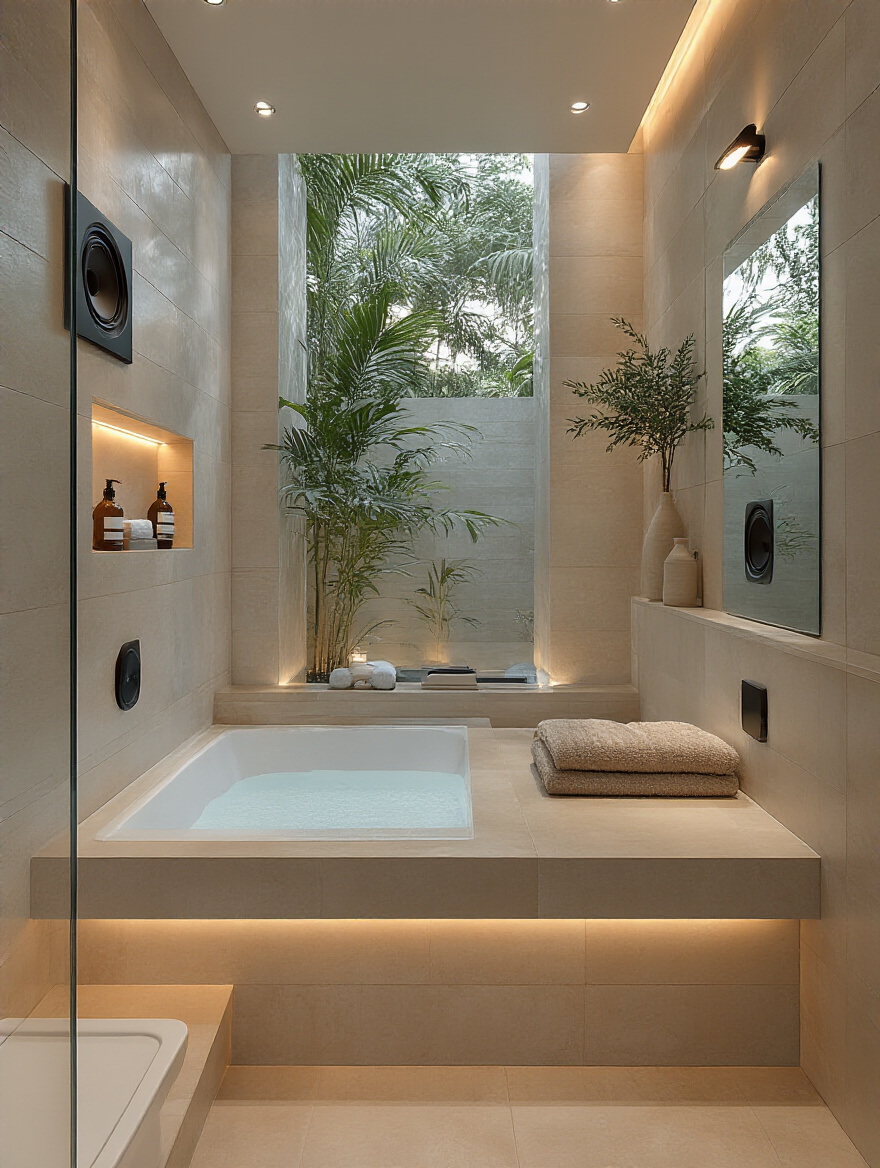
The BS here is thinking you can just put a portable speaker on the counter. It adds clutter, and mixing consumer electronics with water is always a bad idea. The shortcut is to use a system like Sonos, which can easily be integrated. An AV specialist can install in-ceiling speakers that are practically invisible. It is a subtle luxury that has a massive impact on your ability to relax and de-stress in the space.
The small objects we touch every day also have a story to tell.
17. Choose High-Quality, Thoughtful Accessories to Refine Aesthetics
After all the work of creating a calm, beautiful space, don’t ruin it with a cheap plastic soap dispenser and a flimsy towel rack. The accessories are the things you touch. They should feel as good as the room looks. This is about choosing fewer, but better things. A heavy, ceramic soap pump. A solid brass hook. A tray carved from a single piece of marble. These objects have a pleasing weight and texture. They honor the quality of the space.
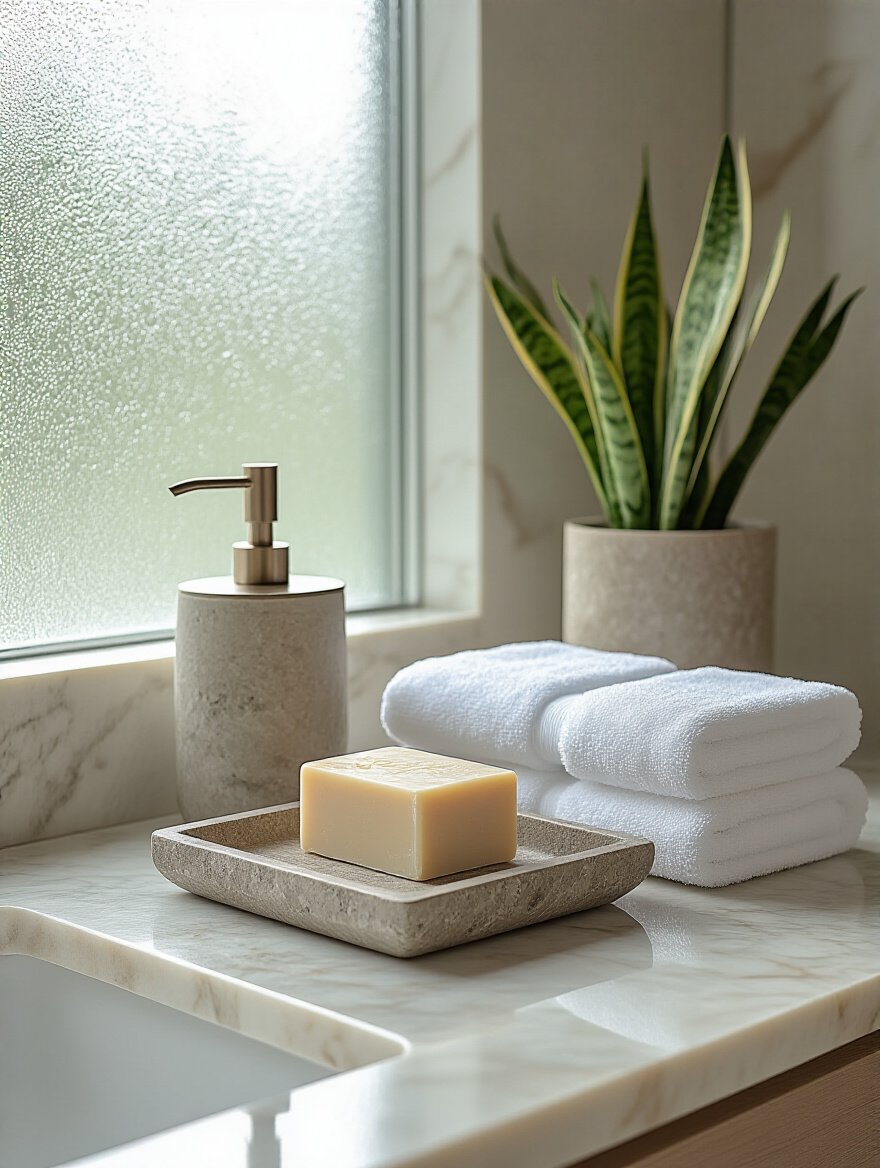
“A room is not finished until you choose the objects that will live there. They are not clutter; they are the final, personal brushstrokes.”
The mistake is over-accessorizing. You don’t need a matching set of everything. Curate. Choose one beautiful tray for the vanity to hold a few essential items. Invest in a set of thick, plush linen or high-quality cotton towels. These are the elements that whisper “luxury,” not because they are expensive, but because they are thoughtful and real.
And finally, we must add a touch of life.
18. Feature Statement Art or Greenery for a Personality Pop
A perfectly designed room with no soul is just a design exercise. It needs a heartbeat. A single piece of statement art or a beautiful, living plant provides this. It’s the one element that is purely you. It disrupts the quiet minimalism just enough to make the room feel personal and alive. It could be a bold, abstract painting that brings a shock of color, or a delicate fern that thrives in the humidity, its green fronds a celebration of life.
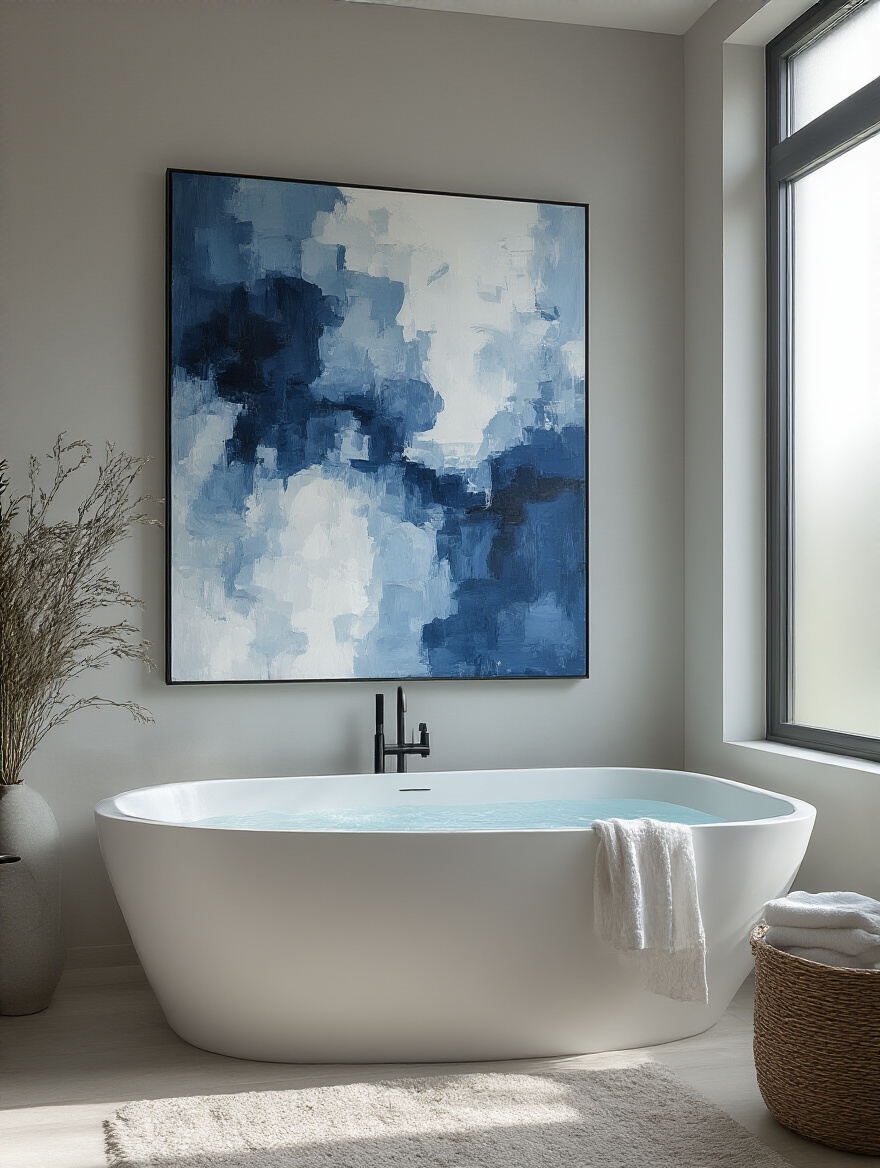
Do not hang a precious watercolor or a paper print; the humidity will destroy it. A canvas, a print on metal, or a photograph under acrylic are better choices. For plants, choose ones that love a wet environment, like an orchid, a snake plant, or a monstera. I once visited a home where the owner had placed a single, perfectly sculpted bonsai on a small teak stool next to the tub. It was the only “decoration” in the room, and it was all the room needed. It was a living sculpture, a point of contemplation.
This brings us to our final touch, where function becomes effortless.
19. Explore Touchless Faucets and Sensors for Enhanced Hygiene and Modernity
A touchless faucet may seem like something from a public restroom, but it has a quiet elegance when brought into the home. There is a sense of magic to it—water that flows with a simple gesture and stops when you are done. It is incredibly hygienic, yes, but it is also an expression of graceful efficiency. It saves water without thought and simplifies the act of handwashing.

The key to getting this right is to choose a model with a beautiful design and an adjustable sensor. Cheaper models can be frustrating, either activating when you don’t want them to or failing to respond when you do. A high-quality touchless faucet feels responsive and intelligent. Paired with a soap dispenser that is also touchless, it creates a clean, seamless, and deeply modern ritual at the sink. It’s a final nod to a future where our homes not only shelter us but actively care for us.
Conclusion
Creating a modern bathroom is not a project in interior decoration. It is an act of crafting a sanctuary. As we’ve seen, it begins with a philosophy of quiet and calm, built on principles like ma and kanso. It is realized through natural materials that ground us, clean lines that calm us, and light that uplifts us.
The journey is about moving beyond a list of features to cultivate a feeling—a feeling of peace, of order, of gentle restoration. This space, which you visit at the start and end of each day, holds the potential to be more than just a room. It can be a place for a daily ritual, a few moments of quiet reflection that set the tone for your life. By making thoughtful, intentional choices, you are not just renovating a bathroom. You are building a haven for your own well-being.
